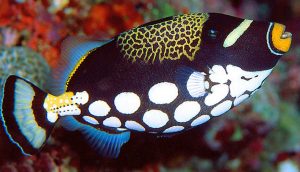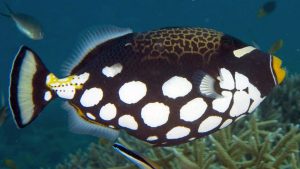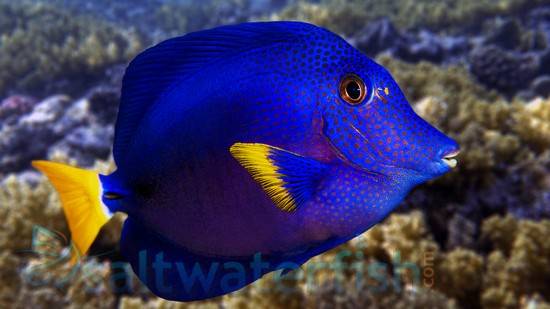The Clown Triggerfish (Balistoides conspicillum) known to tropical fish keeping enthusiasts as the Bigspotted Triggerfish is widely distributed throughout tropical and subtropical waters in the Red Sea, Mediterranean Sea, Pacific and Indian Oceans.
Their range extends from the Indo-Pacific; East Africa to Samoa and the Line Islands in the Central Pacific Ocean. Introduced specimens have been reported in Boca Roton, Florida and the coastal waters of Spain and Israel.
Although they are widely distributed, they are not abundant throughout their range.
Adult Clown Triggerfish are a solitary, extremely aggressive, diurnal species that can be encountered alone, in pairs, and occasionally in harems near steep dropoffs along the outer coral reef slopes of their range at depths from 3 to over 250 feet.
Juvenile Clown Triggerfish are less aggressive and are commonly found at depths below 65 feet where
they shelter among caves, crevices, and overhangs until they reach sexually maturity, usually around one year.
Clown Triggerfish have a black body color with large white blotches along the lower half of the body, a yellow net like pattern on the back just below the dorsal fin, and a broad white stripe that extends from the mid point of the nose to slightly in front and below the eyes. They have a yellow to yellow/orange ring around the mouth encircled by a thin white line. The anal and second dorsal fins are white underlined with a yellow line at their base. The top portion of the caudal peduncle has a yellowish blotch with three horizontal sets of spiny scales. The center of the caudal fin is yellowish with a black margin. The dorsal fin has three spines which comprise the “trigger system” that is characteristic of the Balistidae family. The first longer dorsal is erectile and can be hidden in a dorsal furrow. The second similarily shaped dorsal symmetrically opposes the anal fin.
Because of their belligerent attitude, adult Clown Triggerfish are best housed in a large mature FOWLR aquarium of at least 300 gallon capacity with a sandy or fine coralline gravel substrate, large amounts of live rock arranged into crevices, overhangs, and caves for them to hide among, and plenty of free swimming space.
Because Clown Triggerfish produce a significant amount of waste, they require pristine water conditions. A powerful sump based filtration system or high capacity canister filter, an efficient protein skimmer, a powerhead or wavemaker to create moderate water flow and oxygenation, and weekly water changes of around 10-20% is highly recommended to keep their water free from harmful toxins.
Clown Triggerfish are NOT reef safe and do best in a single species tank or with similarly sized semi-aggressive to aggressive tankmates such as moray eels, large angelfish, groupers, large tangs, large triggers (Picasso or Niger), Lionfish, etc.
Adult Clown Triggerfish thrive when kept alone as the only trigger in the aquarium.
Juvenile Clown Triggerfish are less aggressive and are highly sought after by tropical fish keeping enthusiasts for community tanks but even when first introduced into the aquarium, they quickly get over their initial shyness and will attack less aggressive tankmates; especially other triggerfish. They should not be housed with smaller fish species.
Clown Triggerfish, or any triggerfish should be the very last fish added to an aquarium. If not, they will most likely see any added tank mate as a potential food source.
When kept in a single species tank, Bigspotted Triggerfish can become tame enough to be hand fed by their keepers. However, they have sharp teeth and have been known to take out a chunk of flesh when being fed.
Balistoides conspicillum have not been successfully bred in the home aquarium.
In the wild, juvenile Clown Triggerfish reach sexual maturity at about a year and will begin to form small harems for breeding. In deep water, pairs will clear off a patch in the sand to make a rudimentary nest for the female to deposit her eggs. The male fertilizes them and both parents guard the nest until the eggs hatch out; in approximately 8 days. The female cares for the fry until they can fend for themselves. Juveniles remain in deep water among the crevices, caves, and overhangs until they reach about 6 to 7 inches to begin the life cycle anew.
In their natural habitat, Clown Triggerfish are opportunistic feeders that prey on a varied diet of benthic organisms like echinoderms, mollusks, crustaceans, smaller fish, and occasionally Sea Lillies (crinoids).
In an aquarium environment they thrive on a varied high protein diet of live, fresh, or frozen shrimp, crab, krill, clams, mussels, snails, squid, small pieces of fish, high quality marine pellets, and occasional offerings of marine algae to provide additional fiber. Feeding small portions 2 to 3 times a day is recommended.
Clown Triggerfish (Balistoides conspicillum) are readily available to tropical fish keeping enthusiasts from a variety of online suppliers and specialty fish shops at relatively affordable prices that vary according to size and area of collection.
Approximate Purchase Sizes: Baby: 1/2″ to 1″; Small: 1″ to 2″; Small/Medium 2″ to 3″ Medium: 3″ to 4 1/4″; Medium/Large 4 1/4″ to 5″ Large: 5″ to 6″ X Large 6″ to 7″ XXLarge: 8″ to 9″
Prices range from $ 109.99 to over $ 409.99.
Minimum Tank Size: 300 gallons
Aquarium Type: FOLR
Care Level: Easy
Temperament: Aggressive
Aquarium Hardiness: Hardy
Water Conditions: 74-82° F, dKH 8 – 12°, pH 8.1 – 8.4, sg 1.023-1.025
Max size: 20″
Color Form: Black, White, Blue, Green, Orange, Yellow
Diet: Carnivore
Compatibility: Reef NO
Origin: Indo-Pacific; East Africa to Samoa
Family: Balistidae
Lifespan: 8 – 12 years
Aquarist Experience Level: Intermediate to Advanced






